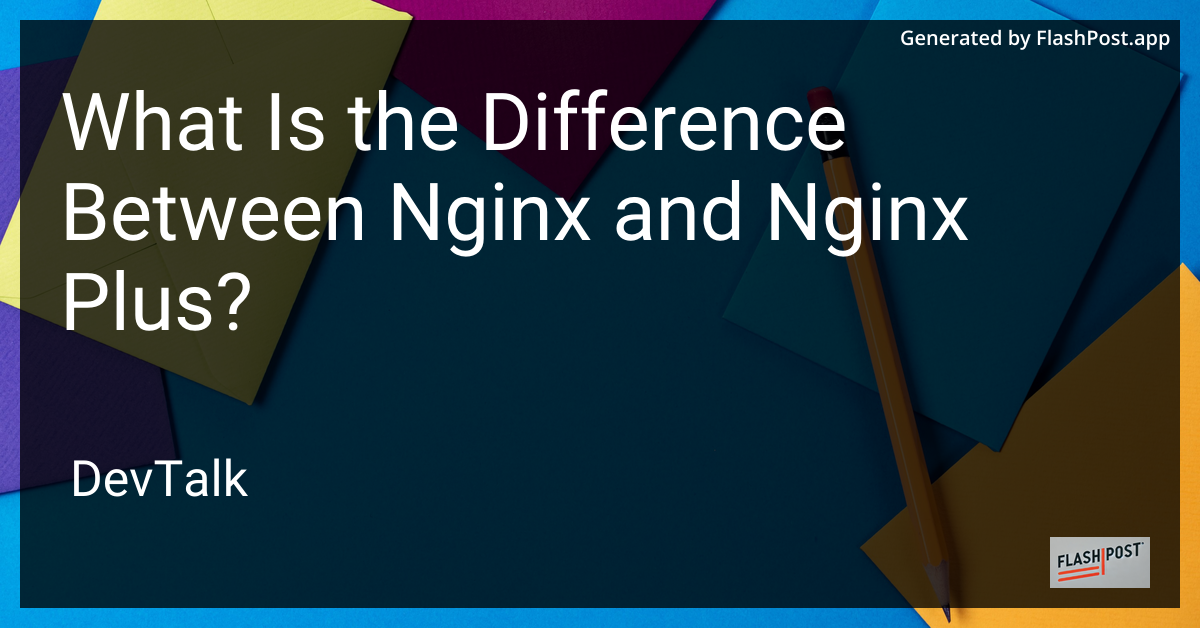What Is the Difference Between Nginx and Nginx Plus?

What is the Difference Between NGINX and NGINX Plus?
In the realm of web server technologies, NGINX has established itself as a robust and high-performing solution for server management, reverse proxy setups, load balancing, and more.
A common point of confusion among users is understanding the differences between the open-source NGINX and its commercial counterpart, NGINX Plus. This article delves into the key distinctions between these two offerings, helping you make an informed decision on which one could best suit your needs.
Understanding NGINX
NGINX is an open-source web server renowned for its high performance, stability, low resource consumption, and scalability. Originally created as a solution to the C10k problem, it efficiently handles many simultaneous connections, making it an excellent choice for serving static content, acting as a reverse proxy, and load balancing.
For more information on how to optimize NGINX's reverse proxy configurations, such as disabling caching, refer to this guide on NGINX reverse proxy.
Introduction to NGINX Plus
NGINX Plus is a commercial extension of NGINX, developed to offer additional features and comprehensive support for enterprise environments. It builds upon the solid foundation of the open-source version but includes enhancements like active health checks, advanced load balancing algorithms, monitoring and management tools, and security features. These enhancements make NGINX Plus particularly appealing for high-traffic, mission-critical applications where performance and reliability are paramount.
Key Differences Between NGINX and NGINX Plus
1. Feature Set
-
Open Source NGINX: Offers a powerful core set of features for handling web traffic, including efficient handling of static content, reverse proxy capabilities, and a suite of load balancing options. However, it lacks some of the advanced features available in its commercial variant.
-
NGINX Plus: Includes everything available in the open-source version of NGINX and adds premium features like application-aware health checks, session persistence, enhanced monitoring and dynamic configuration updates via a REST API, and a Web Application Firewall (WAF).
2. Support and Maintenance
-
Open Source NGINX: Community-driven support through forums, tutorials, and community-generated documentation. This model can be effective but lacks the guaranteed response times and direct assistance from developers.
-
NGINX Plus: Subscription includes 24/7 support and assistance from NGINX developers. This is crucial for enterprises that require immediate responses and solutions to issues.
3. Cost Considerations
-
Open Source NGINX: Free to use, with a wide range of community resources available. Ideal for small to medium-sized projects and developers with technical expertise.
-
NGINX Plus: Requires a paid subscription, which supports product development and offers access to the enhanced feature set. Suitable for enterprises where the benefits of the enhancements justify the additional cost.
4. Monitoring and Management
-
Open Source NGINX: Basic monitoring features available through logs and third-party tools.
-
NGINX Plus: Offers advanced monitoring and management tools, including a live activity monitoring dashboard, exportable metrics, and a robust configuration management system.
Conclusion
Choosing between NGINX and NGINX Plus depends on your project requirements, budget, and support needs. For projects that demand high availability, enhanced security, and dedicated support, NGINX Plus represents a compelling option. On the other hand, NGINX continues to be a powerful tool in its own right, perfectly suited for less critical applications or tech-savvy users comfortable with community support.
For those interested in exploring further, you might find these resources helpful:
- Managing NGINX configurations such as disabling port 80 listening in NGINX.
- Understanding various terms and metrics like connection_time in NGINX.
Both NGINX and NGINX Plus offer incredible power and flexibility, ensuring you can find a solution that perfectly matches your web server needs.